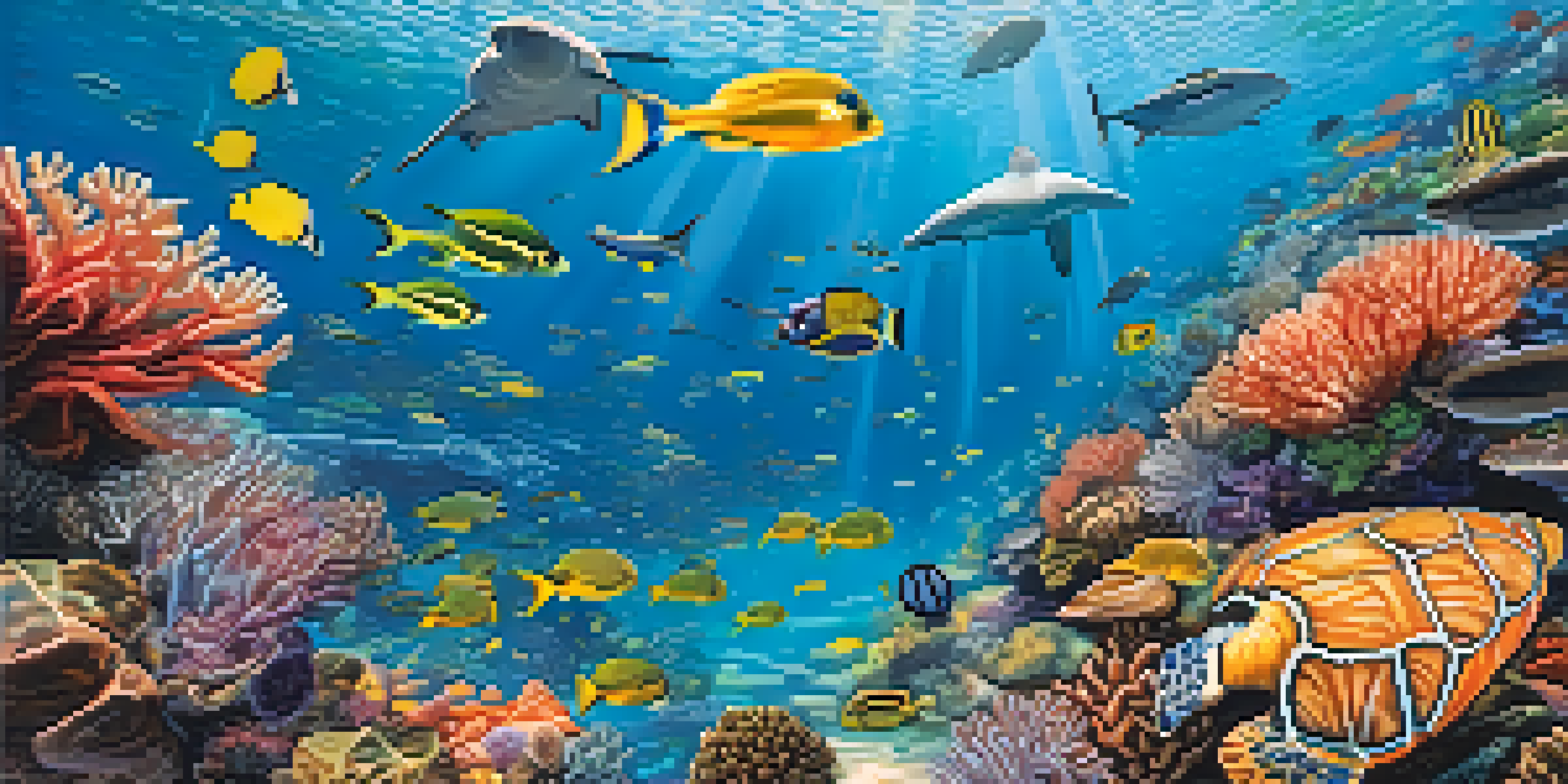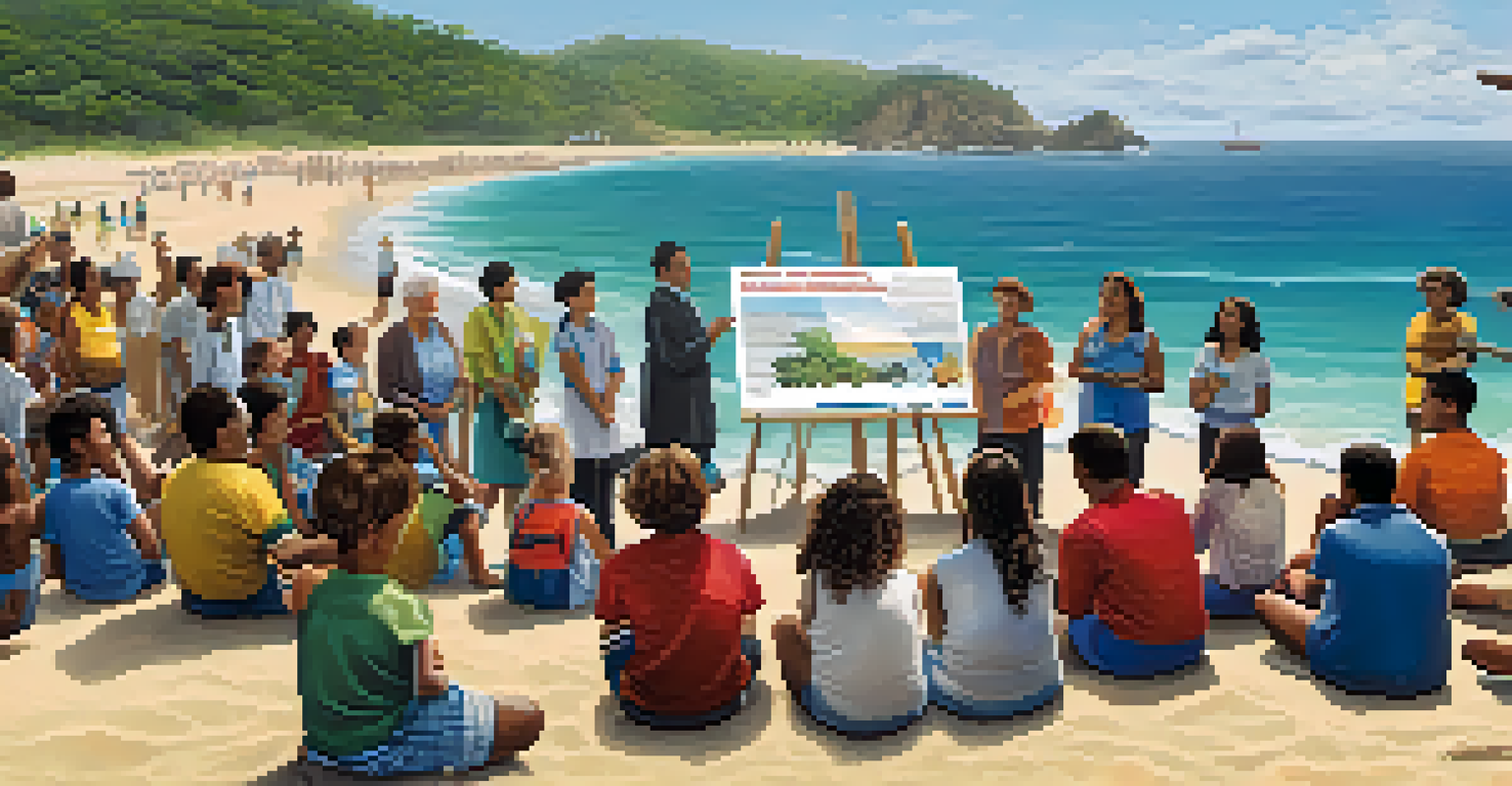The Impact of Climate Change on Brazil's Marine Ecosystems

Understanding Brazil's Rich Marine Biodiversity
Brazil boasts one of the most diverse marine ecosystems in the world, thanks to its extensive coastline and unique geographical features. From the vibrant coral reefs of the Atlantic Forest to the rich estuaries of the Amazon, these waters are teeming with life. Each species plays a critical role in maintaining the balance of the ecosystem, making it essential to understand the potential impacts of climate change.
The ocean is a central component of the global climate system, and its health is crucial for our planet's future.
The country's marine environments are home to countless species, including turtles, dolphins, and a variety of fish. This biodiversity not only supports local economies through fishing and tourism but also contributes to global ecological health. As the climate shifts, the delicate balance of these ecosystems is increasingly threatened, prompting urgent attention.
To grasp the full impact of climate change, it's crucial to recognize that even small changes in temperature or salinity can disrupt food chains and breeding patterns. For instance, warmer waters can lead to coral bleaching, which diminishes habitat for many marine species. Understanding these connections is key to protecting Brazil's marine biodiversity.
Rising Sea Temperatures and Coral Reefs
One of the most alarming effects of climate change is the increase in sea temperatures, which has severe implications for coral reefs. In Brazil, these reefs are not just stunning natural wonders; they are vital ecosystems that support thousands of marine species. Warmer waters can cause coral bleaching, a phenomenon where corals lose their color and, ultimately, their ability to survive.

When corals bleach, they become more susceptible to disease and stress, leading to significant declines in coral cover. This not only affects the corals themselves but also the myriad of fish and marine life that depend on them for shelter and food. Without action, we risk losing these incredible underwater landscapes that are crucial for both the environment and local communities.
Brazil's Marine Biodiversity at Risk
Climate change threatens Brazil's diverse marine ecosystems, impacting species survival and local economies.
Additionally, healthy coral reefs play a vital role in coastal protection, acting as natural barriers against storms and erosion. The loss of coral reefs due to climate change could leave coastal areas more vulnerable to the natural elements, highlighting the interconnectedness of marine health and human safety.
Ocean Acidification: A Silent Threat
Another significant challenge brought on by climate change is ocean acidification. As the atmosphere warms, oceans absorb more carbon dioxide, which leads to a decrease in pH levels. This change can have detrimental effects on marine organisms, particularly those with calcium carbonate shells, such as mollusks and certain types of plankton.
In the end, we will conserve only what we love; we will love only what we understand; and we will understand only what we are taught.
In Brazil, the impacts of ocean acidification can ripple through the food chain, affecting not just the shellfish but also the fish and marine mammals that rely on them for food. This alteration in species availability can threaten local fisheries and the livelihoods of those who depend on them, illustrating the economic stakes involved.
Moreover, ocean acidification can disrupt the delicate balance of marine ecosystems, leading to changes in species distribution and abundance. As certain species struggle to survive, it can create a cascade of effects, making it critical for Brazil to monitor and adapt to these changes.
Impact on Fish Populations and Fisheries
Climate change is also profoundly affecting fish populations in Brazilian waters. Changes in temperature, salinity, and oxygen levels can alter fish migration patterns and breeding grounds, leading to shifts in species distribution. This can make it more difficult for fishermen to predict where to catch certain species, disrupting local economies.
For instance, as waters warm, some fish species may migrate towards cooler waters, potentially leaving traditional fishing grounds barren. This not only impacts the availability of fish but can also lead to overfishing in new areas as fishermen chase after dwindling stocks. Sustainable practices will be crucial to mitigate these disruptions.
Coral Reefs and Coastal Protection
Healthy coral reefs are vital not only for marine life but also for protecting coastal areas from natural disasters.
Additionally, the economic implications of these changes can be significant, threatening food security for communities that rely heavily on fishing as a primary source of income. Understanding these trends is vital for developing adaptive strategies to support both marine ecosystems and the fishing industry.
Threats to Coastal Ecosystems and Mangroves
Brazil's coastal ecosystems, including mangroves and salt marshes, are incredibly important for biodiversity and environmental health. These areas serve as nurseries for many marine species, helping to sustain fish populations. However, climate change poses a significant threat to these vital ecosystems through rising sea levels and increased storm intensity.
Mangroves, in particular, are crucial for protecting coastlines from erosion and flooding. They act as natural buffers, absorbing storm surges and providing habitats for various species. As climate change accelerates, the loss of mangroves could lead to increased vulnerability for coastal communities, emphasizing the need for proactive conservation efforts.
Protecting and restoring these coastal ecosystems is essential not only for marine life but also for the resilience of human communities. Initiatives aimed at reforesting mangroves and reducing coastal development can help combat the impacts of climate change while supporting biodiversity.
The Role of Policy and Conservation Efforts
Addressing the impacts of climate change on Brazil's marine ecosystems requires strong policy frameworks and effective conservation efforts. The Brazilian government, alongside NGOs and local communities, is working to implement strategies that promote sustainability and protect marine biodiversity. This includes establishing marine protected areas and enforcing fishing regulations.
Moreover, public awareness and education play a crucial role in conservation. Engaging local communities in understanding the importance of marine ecosystems can foster a culture of stewardship and encourage sustainable practices. By empowering individuals to take action, we can collectively work towards a healthier ocean.
Need for Conservation Policies
Strong policies and community engagement are essential to safeguard Brazil's marine biodiversity against climate change.
International cooperation is also essential, as marine ecosystems do not adhere to national boundaries. Collaborative efforts can enhance research, share best practices, and develop comprehensive strategies to combat climate change's impact on marine life. Together, we can ensure that Brazil's rich marine biodiversity is safeguarded for future generations.
Looking Ahead: Adaptation and Resilience
As we confront the realities of climate change, adaptation and resilience become key themes for Brazil's marine ecosystems. Developing strategies that allow both marine life and coastal communities to adapt to changing conditions is essential for long-term sustainability. This could include investing in research that focuses on understanding species' responses to climate change.
Additionally, fostering resilient ecosystems through restoration projects can help buffer against some of the adverse effects of climate change. For example, replanting mangroves and restoring coral reefs can enhance their ability to withstand environmental stressors, ultimately benefiting both wildlife and human populations.

Ultimately, the path forward lies in a combination of innovation, collaboration, and community engagement. By working together to protect and restore Brazil's marine environments, we can create a more resilient future that honors the intricate connections between nature and humanity.